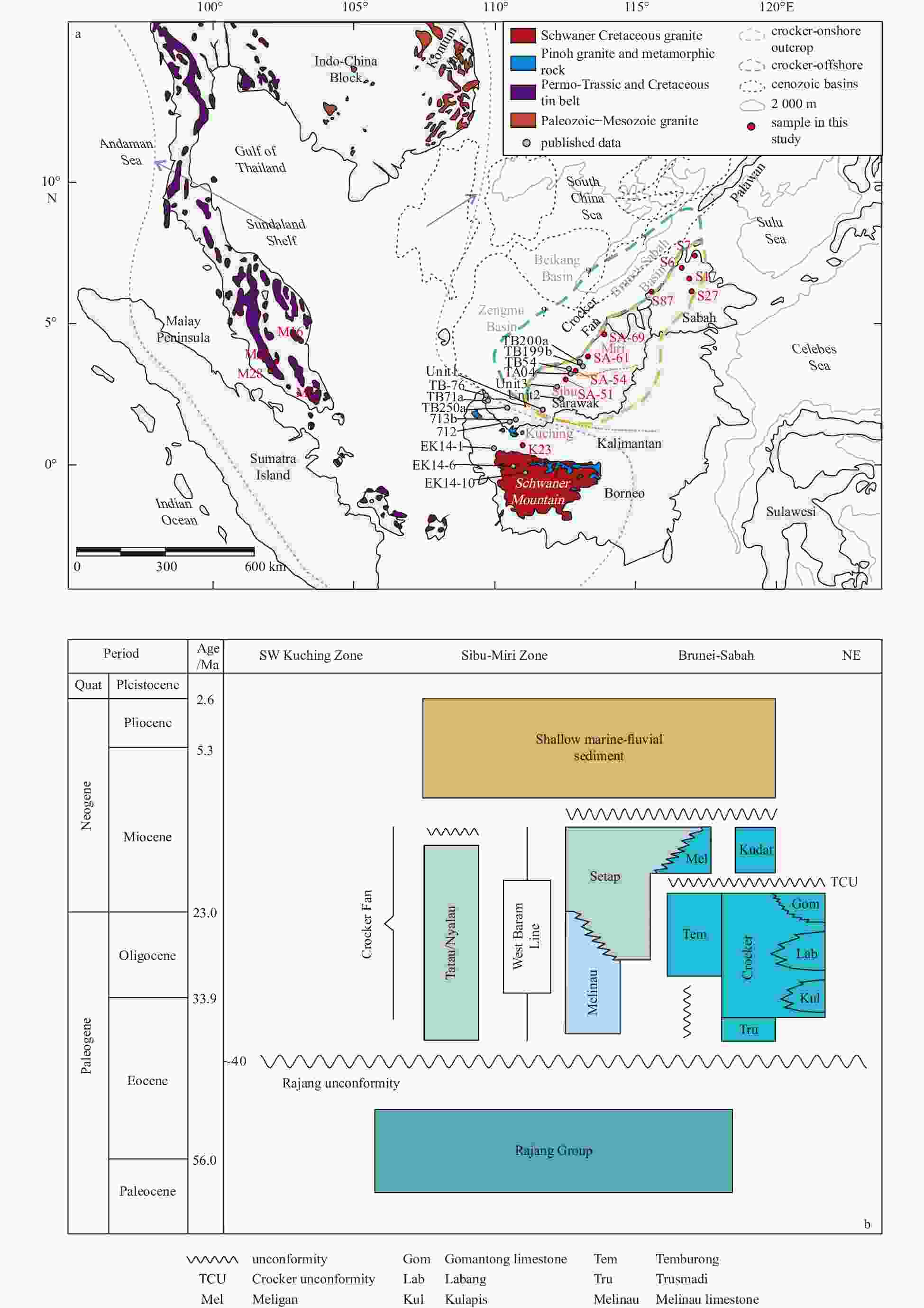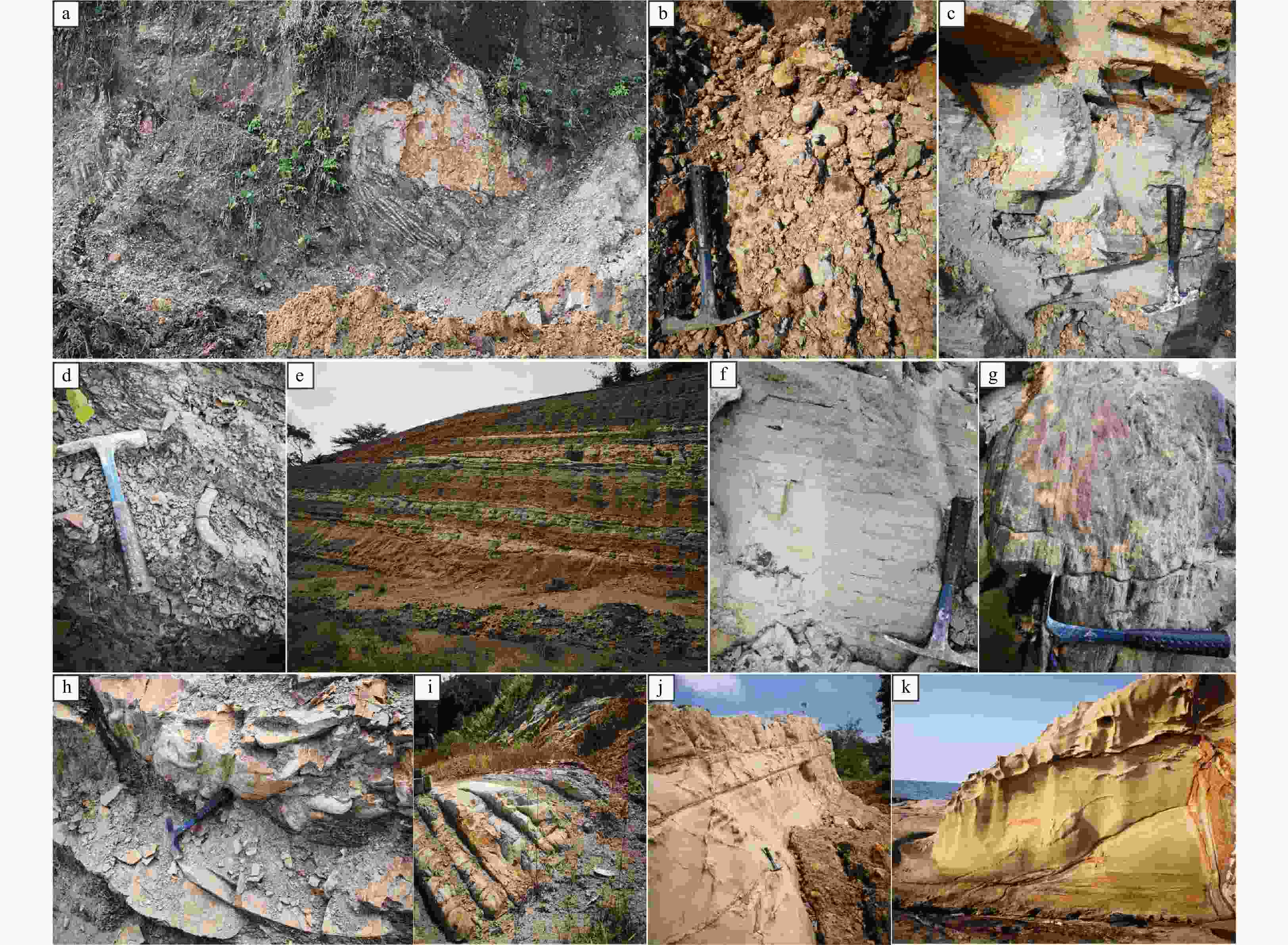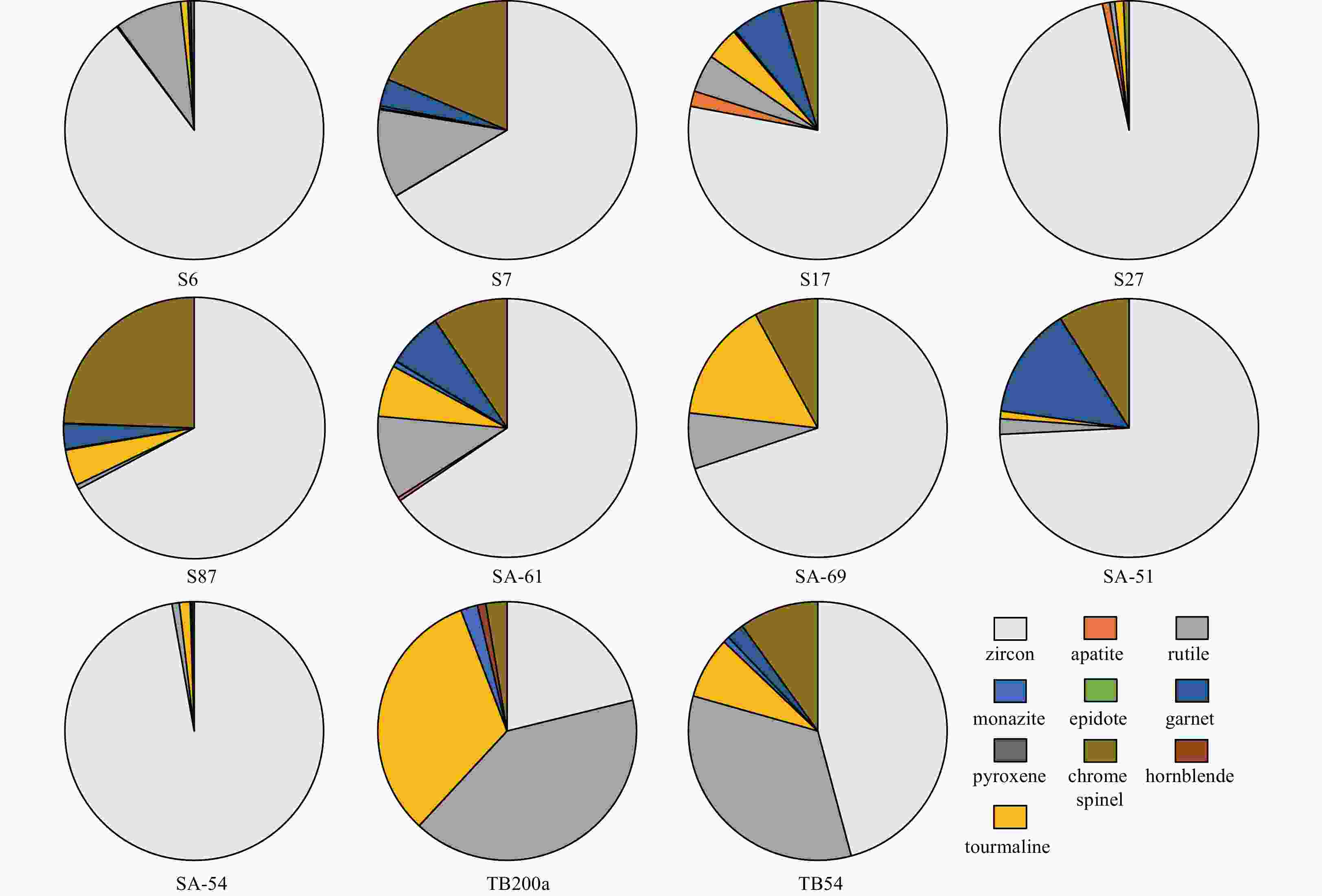Late Eocene–early Miocene provenance evolution of the Crocker Fan in the southern South China Sea
-
Abstract: There are many large-scale Cenozoic sedimentary basins with plentiful river deltas, deep-water fans and carbonate platforms in the southern South China Sea. The Crocker Fan was deposited as a typical submarine fan during the late Eocene–early Miocene, and stretches extensively across the entire Sarawak–Sabah of the northern Borneo area. However, systematic analyses are still lacking regarding its sediment composition and potential source suppliers. No consensus has been reached yet on the provenance evolution and sedimentary infilling processes, which seriously impeded the oil-and-gas exploration undertakings. By combining with sedimentary-facies identification, heavy mineral assemblages, elemental geochemistry and detrital zircon U-Pb dating, this paper aims to generalize an integrated analysis on the potential provenance terranes and restore source-to-sink pathways of the Crocker Fan. In general, the Crocker Fan was initially formed over the Cretaceous–lower/middle Eocene Rajang Group by an angular Rajang unconformity. The continual southward subduction of the proto-South China Sea resulted in magmatic activities and subsequent regional deformation and thrusting along the Lupar Line in the northern Borneo. The lowermost Crocker sequence is featured by a thick conglomerate layer sourced from in-situ or adjacent paleo-uplifts. From the late Eocene to the early Miocene, the Crocker Fan was constantly delivered with voluminous detritus from the Malay Peninsula of the western Sundaland. The Zengmu Basin was widely deposited with delta plain and neritic facies sediments, while the Brunei-Sabah Basin, to the farther east, was ubiquitously characterized by turbiditic sequences. The Crocker Fan successions are overall thick layers of modest-grained sandstones, which formed high-quality reservoirs in the southern South China Sea region.
-
Key words:
- source-to-sink analysis /
- zircon U-Pb age /
- submarine fan /
- Malay Peninsula /
- southern South China Sea
-
Figure 1. Simplified geological map and sample location of the southern SCS (a) and stratigraphic framework of the northern Borneo based on Hall and Breitfeld (2017) (b) speculated geographic extent of the Crocker Fan.
Figure 2. The Rajang Unconformity between the underlain Rajang Group and the overlying upper Eocene Crocker Fan (a); Rangsi conglomerates within the lowermost layer of the Crocker Fan (b); shallow-marine sediments of the Tatau Formation (c); trace fossils perpendicular to the strata, Buan Formation (d); shallow-marine sediments of the Nyalau Formation (e); small cross-beddings in the Nyalau Formation, sandstones interbedded with mudstone laminations (f); limestone of the Setap Shale enriched with foraminiferal fossils, Sabah (g); erosion surface at the lowermost section of the Crocker Fan turbidtes (h); normal upward-graded beddings in the Bouma Sequence (i); wedge-shape sandstone layer, Kudat Formation (j); and thick sandstone layers, Kudat Formation (k).
Figure 3. Heavy mineral assemblages of the Crocker Fan sediments; Samples TB200a and TB54 are compiled data from Hennig-Breitfeld et al. (2019).
Figure 4. Rare earth elemental distribution pattern (PAAS from Taylor and McLennan (1985))(a); TiO2 vs. Zr discrimination plot(b); and Al2O3 vs. TiO2 discrimination plot (based on Hayashi et al. (1997)) (c).
Figure 5. Detrital zircon U-Pb age spectra of the turbidite sediments within the northern Borneo (N represents the number of effective analyses; Samples TB200a, TB54, TA04, TB199b are compiled data from Hennig-Breitfeld et al. (2019); Samples Unit1, Unit2 and Unit3 are compiled data from Galin et al. (2017))
Figure 6. Detrital zircon U-Pb age spectra of the potential source terranes (N represents the number of effective analyses; samples “eastern”, “central” and “western” are compiled data from Sevastjanova et al. (2011); Samples TB250a, 713b and 712 are compiled data from Breitfeld et al. (2017); Samples EK14-1, EK14-6, EK14-10, TB-76, TB71a are compiled data from Hennig et al. (2017))
Table 1. Sample information
Sample No. Age Lithology Method Reference EK14-1 Cretaceous granodiorite zircon U-Pb dating Hennig et al., 2017 EK14-6 Cretaceous quartz diorite zircon U-Pb dating Hennig et al., 2017 EK14-10 Cretaceous diorite zircon U-Pb dating Hennig et al., 2017 TB-76 Cretaceous granodiorite zircon U-Pb dating Hennig et al., 2017 TB71a Cretaceous granodiorite zircon U-Pb dating Hennig et al., 2017 TB54 upper Eocene/Rangsi conglomerate heavy mineral analysis/ Zircon U-Pb dating Hennig-Breitfeld et al., 2019 TA04 upper Eocene /Rangsi conglomerate zircon U-Pb dating Hennig-Breitfeld et al., 2019 TB199b upper Eocene /Rangsi conglomerate zircon U-Pb dating Hennig-Breitfeld et al., 2019 TB200a lower Oligocene/Tatau sandstone heavy mineral analysis/Zircon U-Pb dating Hennig-Breitfeld et al., 2019 TB250a Triassic/Kuching volcaniclastic rocks zircon U-Pb dating Breitfeld et al., 2017 713b Triassic/Sadong volcaniclastic rocks zircon U-Pb dating Breitfeld et al., 2017 712 Triassic/Sadong volcaniclastic rocks zircon U-Pb dating Breitfeld et al., 2017 SA-54 boundary of Eocene and Oligocene strata sandstone heavy mineral analysis this study SA-51 upper Eocene−lower Oligocene/Tatau sandstone heavy mineral analysis this study SA-69 lower Miocene/Lambir sandstone heavy mineral analysis this study SA-61 Oligocene−lower Miocene/Nyalau sandstone heavy mineral analysis this study S87 Oligocene−lower Miocene/Setap sandstone heavy mineral analysis/elemental geochemistry this study S27 Paleocene−lower or middle Eocene/Trusmadi sandstone heavy mineral analysis/elemental geochemistry this study S17 upper Eocene-Oligocene/Crocker sandstone heavy mineral analysis/elemental geochemistry/zircon U-Pb dating this study S7 Oligocene/Kudat sandstone heavy mineral analysis/elemental geochemistry this study S6 Oligocene−Miocene/Wariu sandstone heavy mineral analysis/elemental geochemistry/zircon U-Pb dating this study K23 lower Oligocene/Tebidah sandstone zircon U-Pb dating this study M28 Triassic sandstone zircon U-Pb dating this study M23 Jurassic sandstone zircon U-Pb dating this study M16 Carboniferous sandstone zircon U-Pb dating this study M6 Carboniferous sandstone zircon U-Pb dating this study -
Andersen T. 2002. Correction of common lead in U-Pb analyses that do not report 204Pb. Chemical Geology, 192(1/2): 59–7 Bakar Z A A, Madon M, Muhamad A J. 2007. Deep-marine sedimentary facies in the Belaga Formation (Cretaceous–Eocene), Sarawak: observations from new outcrops in the Sibu and Tatau areas. Bulletin of the Geological Society of Malaysia, 53: 35–45. doi: 10.7186/bgsm53200707 Breitfeld H T, Hall R, Galin T, et al. 2017. A Triassic to Cretaceous Sundaland-Pacific subduction margin in West Sarawak, Borneo. Tectonophysics, 694: 35–56. doi: 10.1016/j.tecto.2016.11.034 Chen Shuhui, Qiao Peijun, Zhang Houhe, et al. 2018. Geochemical characteristics of Oligocene–Miocene sediments from the deepwater area of the northern South China Sea and their provenance implications. Acta Oceanologica Sinica, 37(2): 35–43. doi: 10.1007/s13131-017-1127-7 Compston W, Williams I S, Kirschvink J L, et al. 1992. Zircon U-Pb ages for the early Cambrian time-scale. Journal of the Geological Society, 149(2): 171–184. doi: 10.1144/gsjgs.149.2.0171 Cui Yuchi, Shao Lei, Li Zengxiang, et al. 2021a. A Mesozoic Andean-type active continental margin along coastal South China: new geological records from the basement of the northern South China Sea. Gondwana Research, 99: 36–52. doi: 10.1016/j.gr.2021.06.021 Cui Yuchi, Shao Lei, Yu Mengming, et al. 2021b. Formation of Hengchun Accretionary prism turbidites and implications for deep-water transport processes in the northern South China Sea. Acta Geologica Sinica, 95(1): 55–65. doi: 10.1111/1755-6724.14640 Cui Yuchi, Zhao Zhigang, Shao Lei, et al. 2022. Provenance characteristics and petroleum geological significance of Crocker fan in southern South China Sea. Acta Petrolei Sinica (in Chinese), 43(10): 1427–1438,1473 Galin T, Breitfeld H T, Hall R, et al. 2017. Provenance of the Cretaceous–Eocene Rajang group submarine fan, Sarawak, Malaysia from light and heavy mineral assemblages and U-Pb zircon geochronology. Gondwana Research, 51: 209–233. doi: 10.1016/j.gr.2017.07.016 Haile N S. 1974. Borneo. In: Spencer A M, ed. Mesozoic–Cenozoic Orogenic Belts. Vol. 4. London: Geological Society of London Special Publication, 333–347 Hall R, Breitfeld H T. 2017. Nature and demise of the Proto-South China Sea. Bulletin of the Geological Society of Malaysia, 63: 61–76. doi: 10.7186/bgsm63201703 Hamilton W. 1973. Tectonics of the Indonesian region. Bulletin of the Geological Society of Malaysia, 6: 3–10. doi: 10.7186/bgsm06197301 Hayashi K I, Fujisawa H, Holland H D, et al. 1997. Geochemistry of ~1.9 Ga sedimentary rocks from northeastern Labrador, Canada. Geochimica et Cosmochimica Acta, 61(19): 4115–4137. doi: 10.1016/S0016-7037(97)00214-7 Hennig J, Breitfeld H T, Hall R, et al. 2017. The Mesozoic tectono-magmatic evolution at the Paleo-Pacific subduction zone in West Borneo. Gondwana Research, 48: 292–310. doi: 10.1016/j.gr.2017.05.001 Hennig-Breitfeld J, Breitfeld H T, Hall R, et al. 2019. A new upper Paleogene to Neogene stratigraphy for Sarawak and Labuan in northwestern Borneo: Paleogeography of the eastern Sundaland margin. Earth-Science Reviews, 190: 1–32. doi: 10.1016/j.earscirev.2018.12.006 Hinz K, Fritsch J, Kempter E H K, et al. 1989. Thrust tectonics along the north-western continental margin of Sabah/Borneo. Geologische Rundschau, 78(3): 705–730. doi: 10.1007/BF01829317 Hutchison C S. 1996. The ‘Rajang Accretionary Prism’ and ‘Lupar Line’ problem of Borneo. In: Hall R, Blundell D J, eds. Tectonic Evolution of SE Asia. Vol. 106. London: Geological Society, 247–261 Hutchison C S. 2005. Geology of North-West Borneo. Amsterdam: Elsevier Lambiase J J, Tzong T Y, William A G, et al. 2008. The West Crocker formation of northwest Borneo: A Paleogene accretionary prism. ln: Draut A E, Clift P D, Scholl D W, eds, Formation and Applications of the Sedimentary Record in Arc Collision Zones: Geological Society of America Special paper 436., Boulder, Co, USA: Geological Society of America, 171–184. doi: 10.1130/2008.2436 Li Lini, Zhao Zhigang, Cui Yuchi, et al. 2022. “Source-to-sink” analysis of turbidite deposits in the upper Cretaceous-Eocene Rajang Group in southern South China Sea. Journal of Palaeogeography (in Chinese), 24(1): 61–72 Liechti P, Roe F W, Haile N S. 1960. The Geology of Sarawak, Brunei and the Western Part of North Borneo. Vol. 3. Washington, DC, USA: US Government Printing Office Meng Xianbo, Shao Lei, Cui Yuchi, et al. 2021. Sedimentary Records from Hengchun accretionary prism turbidites on Taiwan Island: Implication on late Neogene migration rate of the Luzon subduction system. Marine and Petroleum Geology, 124: 104820. doi: 10.1016/j.marpetgeo.2020.104820 Mi Lijun, Zhang Zhongtao, Pang Xiong, et al. 2018. Main controlling factors of hydrocarbon accumulation in Baiyun Sag at northern continental margin of South China Sea. Petroleum Exploration and Development (in Chinese), 45(5): 902–913 Sevastjanova I, Clements B, Hall R, et al. 2011. Granitic magmatism, basement ages, and provenance indicators in the Malay Peninsula: Insights from detrital zircon U-Pb and Hf-isotope data. Gondwana Research, 19(4): 1024–1039. doi: 10.1016/j.gr.2010.10.010 Shao Lei, Cui Yuchi, Qiao Peijun, et al. 2019a. Implications on the Early Cenozoic palaeogeographical reconstruction of SE Eurasian margin based on northern South China Sea palaeo-drainage system evolution. Journal of Palaeogeography (in Chinese), 21(2): 216–231 Shao Lei, Cui Yuchi, Stattegger K, et al. 2019b. Drainage control of Eocene to Miocene sedimentary records in the southeastern margin of Eurasian Plate. GSA Bulletin, 131(3/4): 461–478 Shao Lei, Qiao Peijun, Cui Yuchi, et al. 2020. The evolutions of the fluvial systems in the northern South China Sea since the early Cenozoic. Science & Technology Review (in Chinese), 38(18): 57–61 Tang Wu, Zhao Zhigang, Song Shuang, et al. 2021. Differences in the tectonic evolution of basins in the central-southern South China Sea and their hydrocarbon accumulation conditions. Acta Geologica Sinica, 95(1): 30–40. doi: 10.1111/1755-6724.14638 Taylor S R, McLennan S M. 1985. The Continental Crust: Its Composition and Evolution. Oxford: Blackwell Scientific Publications Tian Zhiwen, Tang Wu, Wang Pujun, et al. 2021. Tectonic evolution and key geological issues of the Proto-South China Sea. Acta Geologica Sinica, 95(1): 77–90. doi: 10.1111/1755-6724.14644 Tongkul F. 1991. Tectonic evolution of Sabah, Malaysia. Journal of Southeast Asian Earth Sciences, 6(3): 395–405 van Hattum M W A, Hall R, Pickard A L, et al. 2006. Southeast Asian sediments not from Asia: Provenance and geochronology of North Borneo sandstones. Geology, 34(7): 589–592. doi: 10.1130/G21939.1 van Hattum M W A, Hall R, Pickard A L, et al. 2013. Provenance and geochronology of Cenozoic sandstones of northern Borneo. Journal of Asian Earth Sciences, 76: 266–282. doi: 10.1016/j.jseaes.2013.02.033 Wang P C, Li S Z, Guo L L, et al. 2016. Mesozoic and Cenozoic accretionary orogenic processes in Borneo and their mechanisms. Geological Journal, 51(S1): 464–489 Wilson R A M, Wong N P Y. 1964. The geology and mineral resources of the Labuan and Padas Valley area, Sabah, Malaysia. Kuching: Government Printing Office Yao Yongjian, Wu Nengyou, Xia Bin, et al. 2008. Petroleum geology of the Zengmu Basin in the southern South China Sea. Geology in China (in Chinese), 35(3): 503–513 Yao Yongjian, Xia Bin, Xu Xing. 2005. Tectonic evolution of the main sedimentary basins in southern area of the South China Sea. Gresearch of Eological South China Sea (in Chinese), (1): 1–11 Zhang Gongcheng. 2010. Tectonic evolution of deepwater area of northern continental margin in South China Sea. Acta Petrolei Sinica (in Chinese), 31(4): 528–533, 541 Zhang Hao, Cui Yuchi, Qiao Peijun, et al. 2021b. Evolution of the Pearl River and its Implication for East Asian Continental Landscape Reversion. Acta Geologica Sinica, 95(1): 66–76. doi: 10.1111/1755-6724.14641 Zhang Gongcheng, Feng Congjun, Yao Xingzong, et al. 2021a. Petroleum geology in deepwater settings in a passive continental margin of a marginal Sea: a case study from the South China Sea. Acta Geologica Sinica, 95(1): 1–20. doi: 10.1111/1755-6724.14621 Zhang Houhe, Liu Peng, Liao zongbao, et al. 2018. Geological characteristics and hydrocarbon distribution in major sedimentary basins in Nansha sea areas. China Petroleum Exploration (in Chinese), 23(1): 62–70 Zhang Gongcheng, Mi Lijun, Qu Hongjun, et al. 2013. Petroleum geology of deep-water areas in offshore China. Acta Petrolei Sinica (in Chinese), 34(S2): 1–14 Zhang Gongcheng, Mi Lijun, Wu Shiguo, et al. 2007. Deepwater area—the new prospecting targets of northern continental margin of South China Sea. Acta Petrolei Sinica (in Chinese), 28(2): 15–21 Zhang Gongcheng, Qu Hongjun, Liu Shixiang, et al. 2015a. Tectonic cycle of marginal sea controlled the hydrocarbon accumulation in deep-water areas of South China Sea. Acta Petrolei Sinica (in Chinese), 36(5): 533–545 Zhang Hao, Shao Lei, Zhang Gongcheng, et al. 2020. The response of Cenozoic sedimentary evolution coupled with the formation of the South China Sea. Geological Journal, 55(10): 6989–7010. doi: 10.1002/gj.3856 Zhang Gongcheng, Wang Pujun, Wu Jingfu, et al. 2015b. Tectonic cycle of marginal oceanic basin: A new evolution model of the South China Sea. Earth Science Frontiers (in Chinese), 22(3): 27–37 Zhang Gongcheng, Zhu Weilin, Mi Lijun, et al. 2010. The theory of hydrocarbon genernation controlled by source rock and heat from circle distribution of outside-oil fields and inside-gas fields in South China Sea. Acta Sedimentologica Sinica (in Chinese), 28(5): 987–1005 Zhao Suai, Li Xuejie, Yao Yongjian, et al. 2019. Orogenic events in southern South China Sea and their relationship with the subduction of the Proto South China Sea. Marine Geology & Quaternary Geology, 39(5): 147–162 Zhao Zhigang, Zhang Hao, Cui Yuchi, et al. 2021. Cenozoic sea-land transition and its petroleum geological significance in the northern South China Sea. Acta Geologica Sinica, 95(1): 41–54. doi: 10.1111/1755-6724.14628 Zhu Weilin, Cui Yuchi, Shao Lei, et al. 2021. Reinterpretation of the northern South China Sea pre-Cenozoic basement and geodynamic implications of the South China continent: constraints from combined geological and geophysical records. Acta Oceanologica Sinica, 40(2): 12–28 -





 下载:
下载:








